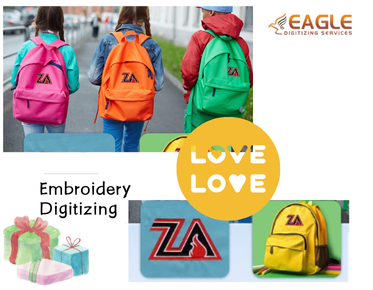Color Separation Success: Screen Printing Tips and Tricks/ Eagle Digitizing
In the world of screen printing, color separation is the unsung hero that ensures your designs turn out as envisioned. It's the process of breaking down a full-color image into separate layers, each representing a specific color. This step is crucial because it dictates how each color will be printed onto the screen and eventually transferred to the fabric. Without precise color separation, your prints may suffer from misalignment, color bleeding, or poor color reproduction. Mastering this technique can significantly elevate the quality of your final product, making your designs not just visible but vibrant and true to their original intent. For the top-notch online vector conversion, don't hesitate to get in touch with us.
Achieving Perfect Prints: How Color Separation Affects Your Final Product
Perfect prints hinge on flawless color separation. When done right, it guarantees that each color is applied accurately, resulting in sharp, vivid, and professional-looking prints. The intricacies of color separation determine whether your design will pop with brilliance or appear dull and muddled. It’s not just about separating colors; it’s about ensuring that each layer aligns perfectly to produce a cohesive and striking final piece. This meticulous process can make the difference between a mediocre print and one that stands out as a piece of art.
Understanding Color Separation
What is Color Separation?: Basics and Overview
Color separation is the process of dividing a full-color image into individual layers, each representing a different ink color used in the printing process. This technique is essential for screen printing, as it allows each color to be applied separately, one layer at a time. The goal is to create a set of film positives or digital files that will guide the screen printing process, ensuring that each color is printed in the correct location and with the right intensity. Understanding the basics of color separation helps in achieving accurate and high-quality prints.
The Role of CMYK vs. Spot Colors: Understanding Different Color Models
Color separation involves choosing the right color model for your project. CMYK (Cyan, Magenta, Yellow, Black) is used for full-color process printing and involves creating a range of colors by mixing these four inks. Spot colors, on the other hand, are pre-mixed inks that are used for specific, often custom, colors. Each method has its benefits: CMYK is versatile and ideal for complex, multi-colored designs, while spot colors provide precise, vibrant hues and are perfect for designs requiring exact color matches. Knowing when to use each model can greatly impact the outcome of your print.
Choosing the Right Software
Top Software for Color Separation: What to Look For
Selecting the right software for color separation is vital for achieving professional results. Look for tools that offer robust color management, precise path editing, and the ability to handle complex layers and masks. Software should provide features that allow for accurate color separation, easy adjustment of color values, and effective layer management. A good color separation tool will streamline your workflow and ensure that your final print is as close to your design as possible.
Comparing Popular Tools: Adobe Illustrator, CorelDRAW, and Other Options
Adobe Illustrator and CorelDRAW are the two leading choices for color separation in vector designs. Illustrator excels with its sophisticated color management and vector editing capabilities, making it a preferred choice for many professionals. CorelDRAW, on the other hand, offers powerful vector tools and user-friendly features that simplify the color separation process. Other options include Affinity Designer and Inkscape, which provide additional versatility and cost-effectiveness. Evaluating these tools based on features, ease of use, and compatibility with your workflow can help you select the best option for your needs. If this post piqued your curiosity and you wish to learn more about vector artwork conversion, feel free to reach out to us.
Preparing Your Artwork
Starting with a High-Quality Image: Why Resolution Matters
The quality of your original image sets the stage for successful color separation. Begin with a high-resolution image to ensure that your design maintains clarity and detail throughout the separation process. A high-resolution file provides the necessary detail for accurate color separation and prevents issues like pixelation or blurriness in the final print. Investing time in preparing a high-quality image will pay off in the form of crisp, vibrant prints.
Preparing Your Design: How to Ensure Clean Lines and Accurate Colors
Before diving into color separation, ensure your design is clean and precise. Remove any stray pixels, ensure that lines are smooth and well-defined, and verify that colors are accurate and consistent. Use tools to adjust and refine your design, checking for any imperfections that might affect the separation process. A well-prepared design is crucial for achieving a professional-looking print with sharp lines and accurate colors.
Using Layers Effectively: Organizing Your Artwork for Easy Separation
Layers are a fundamental aspect of color separation. Organize your artwork into separate layers for each color, allowing you to isolate and manage each color component independently. This organization simplifies the separation process and helps prevent color overlap or misalignment. Labeling and grouping layers logically ensures that you can easily navigate and edit your design, making the separation process more efficient.
Manual Color Separation Techniques
Understanding Manual Methods: When and Why to Separate Colors by Hand
Manual color separation involves physically creating separations for screen printing, often using film positives. This method is useful for designs with specific requirements or for those who prefer a hands-on approach. Manual techniques can offer greater control and precision, especially for intricate or custom designs. However, this method is time-consuming and requires careful attention to detail to ensure accurate color separation.
Using Film Positives: How to Create and Manage Your Film Separations
Creating film positives involves printing each color separation onto transparent film, which is then used to expose the screen. Ensure that each film positive is clear and accurately represents the color separation. Use a high-quality printer and film to achieve sharp and precise separations. Properly manage and store your film positives to avoid issues with alignment or color accuracy during the screen printing process.
Creating Color Separations for Spot Colors
Spot Color Basics: What You Need to Know About Custom Inks
Spot colors are custom inks used to achieve specific, often unique, colors in screen printing. Unlike process colors, which are mixed from CMYK, spot colors are pre-mixed and provide exact color matching. Understanding spot color basics involves knowing how to select and mix inks to achieve the desired hues. Spot colors are ideal for designs requiring vibrant, consistent, and precise color representation.
Separating Spot Colors: Techniques for Accurate and Consistent Results
Separating spot colors requires isolating each color and preparing it for printing. Use color separation software to create individual layers for each spot color, ensuring that each layer corresponds to a specific ink. Double-check color accuracy and consistency across layers to ensure that the final print matches the desired colors. Proper separation techniques are essential for achieving high-quality prints with accurate spot colors.
Using Halftones for Screen Printing
The Basics of Halftoning: How to Create a Range of Tones
Halftoning is a technique used to simulate continuous-tone images by creating patterns of dots. This method allows for a range of tones and shades in screen printing. To create halftones, adjust the dot size, spacing, and pattern to achieve the desired tonal range. Halftoning is crucial for reproducing gradients and photographic images in screen printing.
Choosing the Right Halftone Screen: Dot Patterns and Their Impact
The choice of a halftone screen affects the quality and appearance of your print. Different dot patterns, such as round, elliptical, or stochastic, produce varying visual effects. Select the dot pattern that best suits your design and printing requirements. The screen mesh count also plays a role in determining the dot size and pattern, influencing the final print’s detail and clarity.
Testing Your Separations
Creating Test Prints: How to Check for Accuracy Before Full Production
Before proceeding with full production, create test prints to verify the accuracy of your color separations. Test prints allow you to assess color alignment, registration, and overall print quality. Make any necessary adjustments to ensure that the final prints meet your expectations. Testing helps identify and address potential issues before committing to a large production run.
Common Issues and How to Fix Them: Troubleshooting Color Separation Problems
Common issues in color separation include misalignment, color bleeding, and incorrect color reproduction. To address these problems, check your separation files for accuracy, ensure proper registration during printing, and adjust colors as needed. Regularly inspect and troubleshoot your separations to maintain high-quality prints and avoid costly errors.
Optimizing Your Separations
Adjusting Colors for Better Results: Fine-Tuning Your Separation Files
Fine-tuning your separation files involves adjusting colors, refining paths, and optimizing layer settings. Make precise adjustments to ensure that colors are accurately represented and that each layer aligns correctly. Optimizing your files improves the quality of your prints and ensures that your final product meets your design expectations.
Optimizing for Screen Mesh: Ensuring Your Separations Work with Your Mesh Count
Different screen mesh counts affect the resolution and detail of your prints. Ensure that your color separations are optimized for the mesh count you plan to use. Adjust halftone screens and color separations to match the mesh count, achieving the desired print quality and detail.
Screen Printing Techniques
Understanding Screen Mesh Counts: How Mesh Size Affects Color Separation
Screen mesh counts determine the level of detail and resolution in screen printing. Higher mesh counts provide finer detail and better color accuracy, while lower mesh counts are better suited for larger, more solid designs. Understanding mesh counts helps you select the appropriate screen for your color separations, ensuring optimal print quality.
Choosing the Right Inks: How Different Inks Affect Color Accuracy
Different inks can impact color accuracy and print quality. Choose inks that match your color separations and provide the desired hue and opacity. Consider the type of ink, such as plastisol, water-based, or discharge inks, and how they interact with your screen and fabric. Proper ink selection ensures that your prints are vibrant and true to your design.
Finishing Touches
Final Proofing: Reviewing and Approving Your Separations Before Printing
Before starting full production, conduct a final proofing review of your color separations. Check for any errors, misalignments, or color issues. Approve the proofs once you’re satisfied with the accuracy and quality of the separations. Final proofing ensures that your prints meet your standards and expectations.
Making Adjustments: How to Fine-Tune Separations Based on Proofs
Based on the proofing review, make any necessary adjustments to your color separations. Fine-tune colors, refine paths and address any issues identified during the proofing process. Adjustments ensure that your final prints are accurate and of high quality, aligning with your original design.
The world of screen printing is constantly evolving, with new techniques and technologies emerging regularly. Stay updated with the latest advancements in color separation and printing technology to continually improve your skills and produce cutting-edge prints. Embrace innovation to keep your designs fresh and your prints top-notch.


